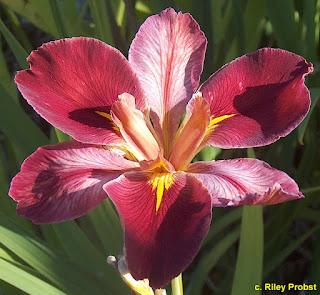By Mel Schiller
Wow what a year so far and it isn't over yet!
In my lifetime I think this year would have to be the windiest by far and as a tall bearded iris grower it spells disaster, especially living on a hilltop. Oh the challenges....I must say, as I type this blog, that we had a forecast of 8mm of rain yesterday and overnight we received much more....27mm.....the weather patterns are all over the place.
Anyway as we are in full swing with our iris season, time spent hybridizing has been down as it has been too wet--I never thought I would say that! Surprisingly the iris are coping well with the extra heavenly water we are receiving. The bloom stems are above and beyond normal this year. We are noticing also that the registered varieties are blooming not according to their registrations. Things that bloom early are blooming mid to late. Late bloomers are blooming mid season; all of this has never happened, until this year!
As the orders are coming in, we are noticing a pattern among purchases. Arils are among the top selling varieties this year and, of course, the broken coloured varieties too.
As it stands here are our top 10 bearded iris for this season.
10. 'Diamonds and Rubies' (Blyth 14) TB What a statement this iris creates!
9. 'Eyes On You' (Black 12) OGB (1/2 Bred) An easing growing Aril variety.
8. 'Spiced Tiger' (Kasperek 96) TB A glowing broken coloured iris. We love it!
7. 'Line Drive' (M Sutton 07) IB A fabulous lined Intermediate iris: it is so pleasing to the eye!
6. 'Rim Of Fire' (Sutton 11) TB An extremely popular iris with that fiery red band on the falls.
5. 'Wicked Good' (Black 12) TB A beautiful blue and black bi-colour iris.
4. 'Lancer' (Shockey 95) OGB A nice contrast in colour.
3. 'Nigerian Raspberry' (Kasperek 95) TB Oh so pretty!
2. 'Serengeti Spaghetti' (Kasperek 99) TB An easy growing variety.
1. 'Sand Dancer '(Tasco 10) OGB A favourite of ours and it is oh so different.
It is great to see so many people enjoying their gardens and wanting to make an impact with the bearded iris being a highlight to there garden. We personally love to plant iris with roses, lavender, alstroemeria, snap dragons, and aquilegias.
We are mid season at the moment and have met so many new people to iris. We hope you all continue with your love of gardening and creating a pleasant space for wind down time from this ever hectic, anxious world we now live in. Until next time....Happy Gardening 💜


















































